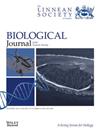Dolphins from a prehistoric midden imply long-term philopatry of delphinids around Tokyo Bay
IF 1.5
3区 生物学
Q3 EVOLUTIONARY BIOLOGY
引用次数: 0
Abstract
Cetaceans of the family Delphinidae are widely distributed throughout the global ocean, and it has been suggested that females exhibit philopatry. However, the duration of time that a maternal group of these highly mobile creatures spends inhabiting a particular region remains unknown. The objective of this study is to examine the genetic diversity of delphinids in the past and to shed light on the above question. In this study, we amplified and sequenced the mitochondrial DNA D-loop region from the skeletal remains of delphinids that were excavated from the Shomyoji Midden, a site situated on the western coast of Tokyo Bay and dating to 5000–3000 years before the present. We acquired prehistoric D-loop sequences of seven bottlenose dolphins, six Pacific white-sided dolphins, and a false killer whale. Notably, one or more haplotypes from the prehistoric individuals were detected in the geographically proximate modern conspecific populations across all three species. Whilst the genetic diversity of prehistoric and modern Pacific white-sided dolphin populations appears to be comparable, the modern bottlenose dolphin population demonstrates significantly lower genetic diversity when compared to its prehistoric counterpart in the vicinity of Tokyo Bay. The maternal groups of these species are speculated to have persisted in the same habitat for at least 4000 years.来自史前洞穴的海豚暗示了东京湾附近海豚的长期哲学
海豚科的鲸目动物广泛分布在全球的海洋中,有人认为雌性海豚表现出了“哲学性”。然而,这些高度移动的生物的母系群体在特定地区居住的时间仍然未知。本研究的目的是研究过去海豚的遗传多样性,并阐明上述问题。在这项研究中,我们从位于东京湾西海岸的shoomyoji Midden遗址出土的海豚骨骼遗骸中扩增并测序了线粒体DNA d环区域,该遗址可追溯到距今5000-3000年前。我们获得了7只宽吻海豚,6只太平洋白边海豚和一只假虎鲸的史前d环序列。值得注意的是,在所有三个物种的地理位置接近的现代同种种群中发现了来自史前个体的一个或多个单倍型。虽然史前和现代太平洋白边海豚种群的遗传多样性似乎是相似的,但与东京都湾附近的史前海豚种群相比,现代宽吻海豚种群的遗传多样性明显较低。据推测,这些物种的母系群体在同一个栖息地中生存了至少4000年。
本文章由计算机程序翻译,如有差异,请以英文原文为准。
求助全文
约1分钟内获得全文
求助全文
来源期刊
CiteScore
4.30
自引率
10.50%
发文量
140
审稿时长
3-6 weeks
期刊介绍:
The Biological Journal of the Linnean Society is a direct descendant of the oldest biological journal in the world, which published the epoch-making papers on evolution by Darwin and Wallace. The Journal specializes in evolution in the broadest sense and covers all taxonomic groups in all five kingdoms. It covers all the methods used to study evolution, whether whole-organism or molecular, practical or theoretical.d.

 求助内容:
求助内容: 应助结果提醒方式:
应助结果提醒方式:


